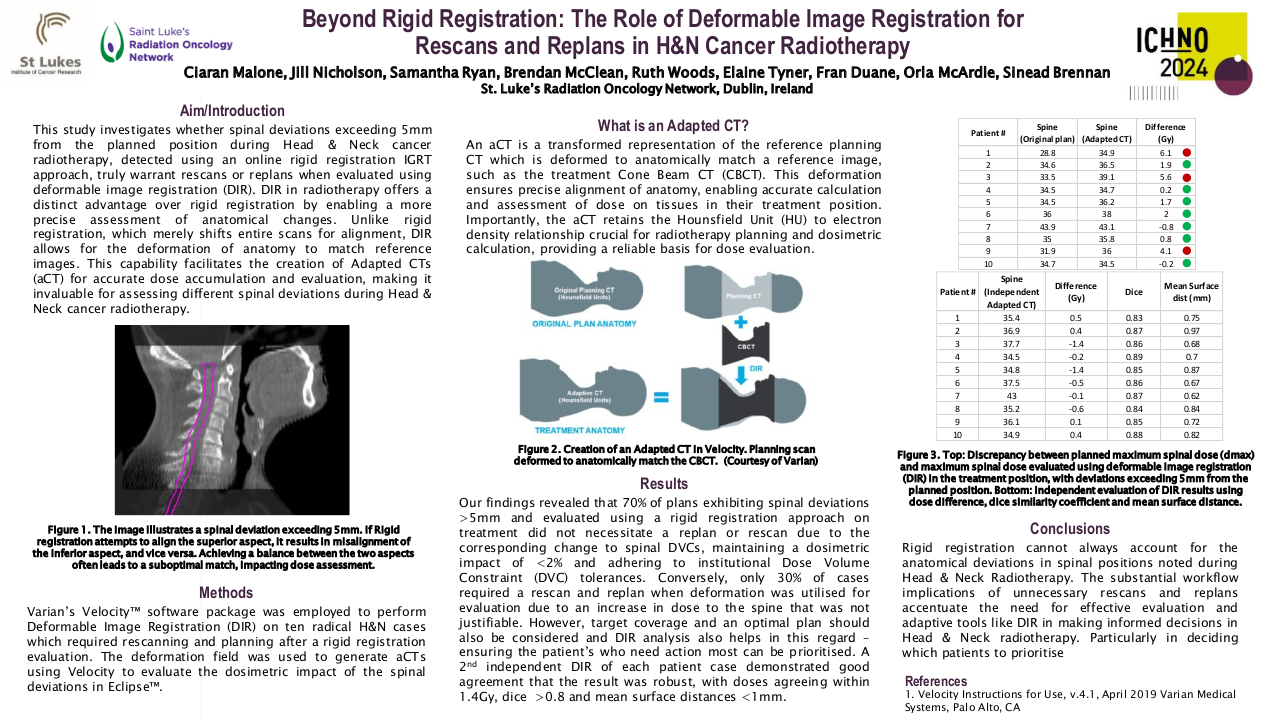It takes two… validating a novel use of dual registration for Glottic radiotherapy treatment
Purpose/Objective
Contemporary external beam photon head and neck radiotherapy is characterised by highly conformal delivery techniques that allow high doses to complex target areas. This demands commensurate accuracy and precision due to reduced expansion margins, steep dose gradients and proximity to critical organs OARs.
IGRT is essential to ensure optimal radiotherapy delivery and requires robust, reliable registration of both target volumes and OARs. Automated rigid registration algorithms provide rapid alignment however one of the most challenging scenarios in IGRT is the potential for primary target volume displacement.
A recent audit in the authors department involving 172 patients found that 17% of those experienced primary target baseline shifts, mainly in the longitudinal plan, at some time during their treatment. The majority were systematic and the most common site was glottic cancer.
Our department wanted to evaluate the accuracy of image registration using the XVI system (Elekta, Stockholm, Sweden) dual registration tool (DRT) for use in glottic radiotherapy. DRT allows an assessment of baseline registration (usually to proximal bony anatomy) and a soft tissue region of interest (mask) sequentially and quantifies differences between them. Dual registration has previously been investigated for prostate [1], inferior neck nodes [3] and chest wall [2] .
We wanted to validate DRTs accuracy and reliability prior to its integration within a departmental IGRT head and neck guidance framework. This framework contains stipulated action levels based on thresholds that would be augmented by DRTs ability to quantify the magnitude of primary tumour baseline shifts. The first objective was to establish the accuracy of DRTs soft tissue mask registration algorithm to primary glottis tumour targets; the second was to assess inter-observer consistency of agreement between RTTs.
Material/Methods
This retrospective study used 36 randomly selected XVI images from 18 glottic patients. To establish the accuracy of DRT mask soft tissue registration algorithm with glottis primary lesions it was compared to a gold standard registration (GSR). This registration was defined by a departmental IGRT specialist RTT with 18 years’ experience of online head and neck image review. Proposed couch shifts for both matches were recorded in the right/left (RL), superior/inferior (SI) and anterior/posterior (AP) directions.
To assess inter-observer reliability of DRT between RTTs, three RTTs with varying levels of experience in image registration were asked to performed a dual registration on all images and select the most appropriate match (baseline, mask or hybrid) using the head and neck IGRT framework as guidance. Proposed couch shifts were recorded in the RL, SI and AP directions.
Bland-Altman 95% Limits of Agreement (LoA) were used to assess agreement between the DRT and GSR matchings. To analyse agreement between RTT’s a modified Bland-Altman process described by Jones et al [4] was utilised.
A clinical threshold of 3 mm was predetermined for both statistical methods. This threshold was deemed appropriate as our department has an action level of 3 mm for these patients.
Dual registration baseline registration was defined through a cuboidal region of interest around the cervical spine adjacent to PTVs. The mask region of interest was defined as the planned GTV structure with a margin of 0.5cm.
Results
For the comparison between the soft tissue mask-GSR a total of 72image registrations were performed (36 per method). The 95% LoA in the left/right, superior/inferior and anterior/posterior directions were −1.40 to +1.66 mm, −2.07 to +2.54 mm, and −2.17 to +2.67 mm, respectively. One mask CBCT match (2.8%) was beyond the 3-mm threshold in the anterior/posterior direction.
108 image registrations were performed for the assuming of inter-observer reliability of DRT between RTTs (36 image registration per RTT). The 95% LoA between RTTs in the left/right, superior/inferior and anterior/posterior directions were −1.21 to +1.30 mm, −2.39 to +2.90 mm and −1.46 to +1.81 mm, respectively. Three RTT CBCT matches (2.8%) were outside the 3-mm threshold. All matches beyond 3mm were in the superior/inferior direction.
Conclusion
This is the first work to investigate a novel use of XVI DRT during image registration for glottis head and neck radiotherapy. The findings of this study demonstrate that DRTs mask functionality provides accurate registrations to primary target volumes and are considered clinically acceptable when compared with an expert GSR for this cohort of patients. The use of DRT was also considered reliable when used by RTTs operating under the guidance of a clinician-led IGRT framework. The introduction of DRT allows accurate quantification of primary target baseline shifts, identifying cases for rapid escalation to clinicians whilst extending and standardising RTT IGRT scope of practice.
1. Campbell A, Owen R, Brown E, Pryor D, Bernard A, Lehman M. Evaluating the accuracy of the XVI dual registration tool compared with manual soft tissue matching to localise tumour volumes for post-prostatectomy patients receiving radiotherapy. J Med Imaging Radiat Oncol. 2015;59:527–342. Goldsworthy S, Leslie-Dakers M, Higgins S, Barnes T, Jankowska P, Dogramadzi S, et al. A pilot study evaluating the effectiveness of dual-registration image-guided radiotherapy in patients with oropharyngeal cancer. J Med Imaging Radiat Sci. 2017;48:377–843. Mohandass P, Khanna D, Kumar TM, Thiyagaraj T, Saravanan C, Bhalla NK, Puri A. Study to Compare the Effect of Different Registration Methods on Patient Setup Uncertainties in Cone-beam Computed Tomography during Volumetric Modulated Arc Therapy for Breast Cancer Patients. J Med Phys. 2018 Oct-Dec;43(4):207-2134. Jones M, Dobson A, O’Brien S. A graphical method for assessing agreement with the mean between multiple observers using continuous measures. Int J Epidemiol 2011; 40: 1308–13








